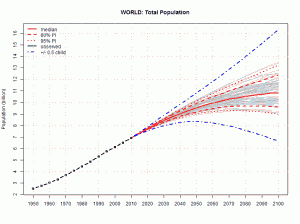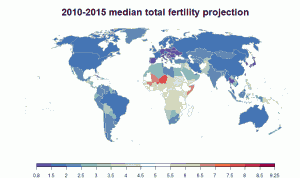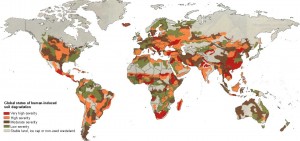Is a World of 29 Billion People Sustainable?
Jul 23rd, 2014 | By admin | Category: Environment/SustainabilityBy Suzanne York, www.howmany.org
“Can Earth Handle 29 Billion People? Easy.”
Where to begin with this statement? Actually, it’s the title of an editorial in the Financial Post of Canada by one Lawrence Solomon, described as “one of Canada’s leading environmentalists.” This editorial was preceded by another on the same theme and is based on the United Nations high-range population projection for 2100.
It’s a little shocking to think of a planet of 29 billion people, given the current state of the world, and one that is using the equivalent of 1.5 Earths today to provide the resources we all use and absorb our waste. Imagine how many Earths we would need if there were 29 billion people.
Mr. Solomon is certainly free to state what he believes, but his writing contains some grandiose statements that don’t jive with reality.
An Aging Globe
Take this one, for example: “Since 2000, fertility rates have risen in Canada, Australia, the U.K., France and the Netherlands, while others in the developed world, like Germany and Japan, seem set to join the party.”
There may be a slight increase in the total fertility rate in a few of these countries, but all are still at or below replacement rate, according to the Population Reference Bureau (PRB), which analyzes population demographics. Total fertility rates for the above-mentioned countries, as of 2012, are:
Canada – 1.6
Australia – 1.9
U.K. – 2.0
France – 2.0
Netherlands – 1.7
Fertility, notes PRB, can also appear to rise and then suddenly fall. While population growth is still increasing in these countries, it is due mostly to immigration, not to fertility rates. And the news on Japan has been focused on how its population continues to age and shrink. However, this past January the Japanese government reported that the total fertility rate rose to an average of 1.43, which amounted to an increase of 0.02 point over 2012. Yet last year, the lowest number of children ever born in Japan was recorded. The UN has reported that “population ageing is taking place almost everywhere in the world.”
And despite Mr. Solomon’s assertion that “we are still making babies at a good clip,” to quote the UN again, “Fertility has fallen since the 1970s in the vast majority of countries or areas in Africa, Asia, Latin America and the Caribbean and Oceania.” And, “Many countries, including most in Europe and Northern America, have had below-replacement fertility for two or three decades.”
The Human-centric View: Earth is Limitless
Or take this statement by Mr. Solomon (recall he is supposedly one of Canada’s leading environmentalists), “With vast discoveries of shale gas and shale oil creating energy gluts in every continent on Earth, and with the Third World’s food crisis becoming one of obesity rather than starvation, the world is waking to the realization that Earth’s bounty is limitless.”
There may well be “vast discoveries of shale gas,” but the world is paying a high price for it. Just ask the First Nations people in the Athabasca tar sands region of Alberta. And like conventional oil, it’s not limitless. Oilsands (tar sands) are the fastest growing source of greenhouse gas emissions in Canada.
The News on the State of the World
A glance at the news of the past week reflects concern about the state of the world, one struggling with handling its current population’s needs.
Trisha Mahajan, a reporter with Reuters, wrote this week about how New Delhi is struggling to meet the needs of its burgeoning population. The city is home to 25 million people – more than the population of Australia. Hopefully Mr. Solomon’s Urban Renaissance Institute is planning to invest in and fund projects to help Delhi cope with its rapid growth. Mahajan said, “Poor infrastructure has given rise to numerous slums across the city. Water and power shortages, inadequate healthcare facilities, dilapidated schools, are common in India’s urban areas.” Earlier this year, the World Health Organization declared that Delhi’s air is the most polluted in the world.
Elsewhere, in a report issued last week, researchers in England found increasing degradation of the planet’s soil is threatening to push up food prices and increase deforestation. John Crawford, Director of the Sustainable Systems Programme in Rothamsted Research, said “Under business as usual, the current soils that are in agricultural production will yield about 30 percent less than they would do otherwise by around 2050.”
Industrial agriculture (think pesticides and monocultures) and overgrazing are wreaking havoc on the world’s soil. The United Nations’ Food and Agriculture Organization has estimated that 25 percent of agricultural land is highly degraded, while a further 8 percent is moderately degraded.
One final news story of note is about Africa. Researchers from African, American and European universities meeting in Cameroon stated Africa may lose up to 30 percent of its animal and plant species by the end of the century due to global warming, population growth and unregulated development.
The researchers said sub-Saharan Africa is losing forested land faster than any place on Earth, due to demand for timber from overseas. According to the UN Population Division, over 80 percent of the increase in the projected overall population size, whether by 2050 or 2100, will be absorbed by Africa.
Nigeria, for example, is predicted to have a five-fold increase in its current population of 173 million by 2100. If girls’ education, family planning, human rights, and security aren’t at the top of the agenda soon, imagine the troubles in Nigeria compounded by such an increase in people.
The Ghost of Malthus
Mr. Solomon pulls out an oldie but still apparently a goodie, that of cutting down Paul and Anne Erhlich’s Population Bomb, as well as Limits to Growth. Yes, like Malthus, the Erhlich’s did not account for the role of technology, and their predictions in 1968 did not come to pass due to the Green Revolution. However, it is intriguing to note what Norman Borlaug, founder of the Green Revolution, thought about population.In his acceptance speech for the Nobel Peace Prize in 1970, Borlaug said “Most people still fail to comprehend the magnitude and menace of the ‘Population Monster’.” The New York Times noted that Borlaug was frustrated throughout his life that governments did not do more to tackle population growth by lowering birth rates, and at one point said “If the world population continues to increase at the same rate, we will destroy the species.”
It’s interesting, or rather sad, that Mr. Solomon appears to completely disregard nature, as if it doesn’t count for much, or as if people aren’t part of the ecosystem and don’t rely on it for just about everything. He writes, apparently seriously, “Even if the world’s population became twice 29 billion, or 58 billion, its population density of 430 people per square kilometer would still fall short of the Netherland’s nearly 500 people per square kilometer density. The Netherlands is likewise known for its clean environment and advanced economy, as well as for its high quality of life…”
The Netherlands, like many developed nations, has a history of colonizing and taking resources from native populations that helped it become an advanced economy. And what about nature? There are green spaces in the Netherlands, which is about the size of Maryland, but not a large variety of wild animals. And globally it is more an exception and not the rule in terms of public transit and biking. Go to Addis Ababa or New Delhi and see how cars rule the road.
The Needs of Women and the Promise of Technology
It might be different if women didn’t want voluntary family planning services. Yet there are some 222 million women in the developing world who want to plan their families and their lives but have an unmet need for modern contraception. Women in developed countries like having access to contraceptives too.
Can technology save us? Yes, it’s likely that current and future inventions will improve the lives of many people. But some of this comes at a steep price. Genetically-engineered foods in particular. Is it worth putting food security, human health, and the environment at risk, or try and meet our needs in an organic and sustainable way. Feeding 10 billion, much less 29 billion, even without organic foods will be challenging.
Human ingenuity should be taken into account, but so should reality. And today’s reality is one of climate change, high rates of inequity and inequality, weak gender rights, and an environment under siege for precious resources.
I don’t know what number is a “sustainable population” size. But I’m pretty sure – no positive – that it’s not 29 billion people. The fact is that there are 7 billion people on the planet today, and there will be 1-3 billion more by 2050, whose needs should be met and human rights respected.
For someone to say having 29 billion people on Earth in less than a century will be “easy” is wearing rose-colored glasses, and worse, is ignoring the political, social and environmental reality of our world.
Suzanne York is a senior writer with the Institute for Population Studies.





